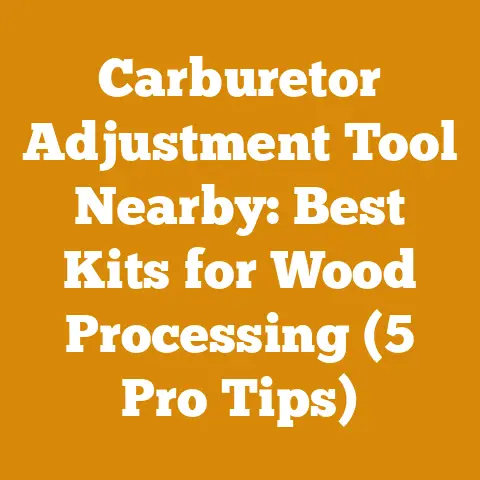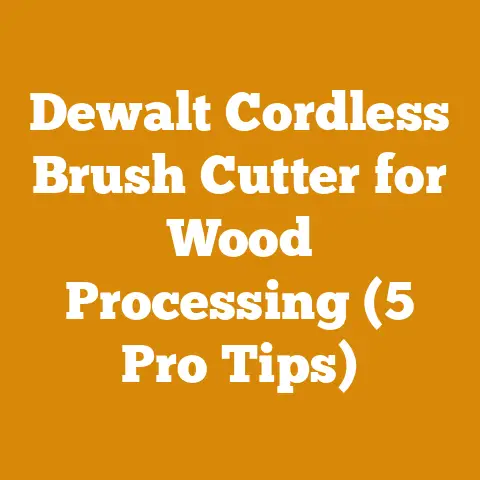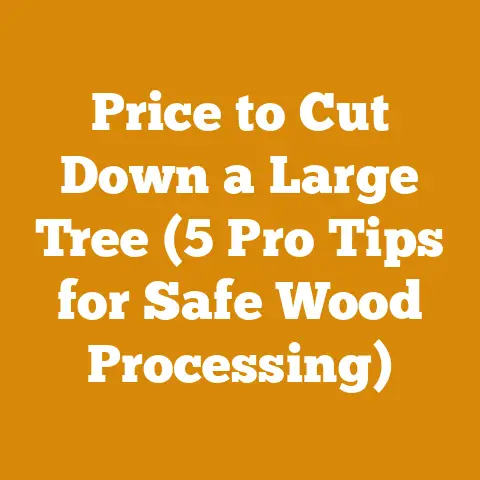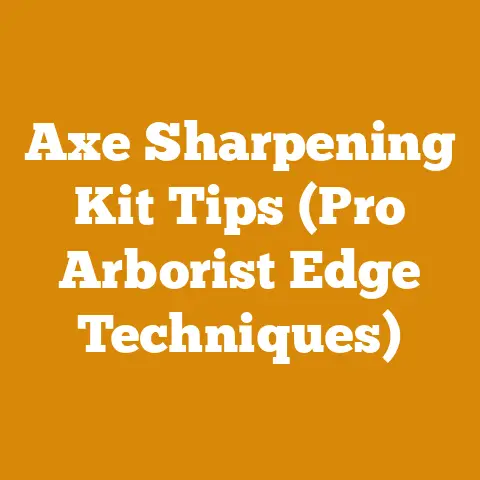14 Inch Brush Cutter Blade Types Explained (Pro Arborist Insights)
Let’s cut to the chase: choosing the right brush cutter blade can dramatically increase your cutting efficiency and reduce strain, saving you time and energy on every project. In this guide, I’ll walk you through the various 14-inch brush cutter blade types, sharing insights I’ve gained from years of experience in the field, from clearing overgrown trails to managing dense underbrush on logging sites.
Understanding 14-Inch Brush Cutter Blades: A Pro Arborist’s Guide
Brush cutters are indispensable tools for managing vegetation, especially in areas where a lawnmower simply won’t cut it. The 14-inch blade size is a popular choice, striking a balance between cutting width and maneuverability. But with so many blade types available, selecting the right one can be daunting. I’ve seen firsthand how using the wrong blade can lead to frustration, inefficiency, and even potential injury. My goal here is to equip you with the knowledge to make informed decisions, ensuring you get the most out of your brush cutter.
What is a Brush Cutter?
A brush cutter is essentially a powerful, handheld tool designed to cut through thick grass, weeds, brush, and even small trees. They are often powered by gasoline engines or electric motors and utilize a rotating blade at the end of a long shaft. Think of it as a more robust, versatile version of a weed whacker.
Why 14-Inch Blades?
The 14-inch blade diameter is a sweet spot. It provides a decent cutting swath, allowing you to clear areas relatively quickly, while still being manageable, especially in tight spaces or on uneven terrain. Larger blades can be more efficient in open areas but can be cumbersome and potentially more dangerous in confined spaces. I’ve found that a 14-inch blade is often the best compromise for general-purpose use.
Key Terminology: Getting on the Same Page
Before diving into the different blade types, let’s define some key terms to ensure we’re all on the same page:
- Brush Cutter Head: The part of the brush cutter that holds the blade.
- Arbor Size: The diameter of the hole in the center of the blade, which determines compatibility with your brush cutter. This is crucial! Always check your brush cutter’s specifications before purchasing a blade.
- Cutting Swath: The width of the area that the blade cuts in a single pass.
- Blade Material: The type of metal used to make the blade, typically steel or a steel alloy. This affects the blade’s durability, sharpness, and ability to withstand impacts.
- Tooth Count: The number of cutting teeth on the blade. Generally, more teeth result in a smoother cut, while fewer teeth are better for aggressive cutting of thicker vegetation.
- Kerf: The width of the cut made by the blade.
- Kickback: A sudden, forceful reaction when the blade encounters a solid object, causing the brush cutter to jerk back towards the operator. This is a serious safety hazard.
Exploring Different 14-Inch Brush Cutter Blade Types
Now, let’s explore the different types of 14-inch brush cutter blades, focusing on their characteristics, applications, and my personal experiences with each.
1. Multi-Tooth Blades (Circular Saw Blades)
- Description: These blades resemble miniature circular saw blades, featuring numerous teeth arranged around the perimeter. They are typically made from hardened steel and can have anywhere from 40 to 80 teeth or more.
- Applications: Ideal for cutting through thick grass, weeds, brambles, and small saplings. They provide a clean, precise cut and are well-suited for clearing areas where a neat finish is desired. I often use these for clearing around newly planted trees, where I want to avoid damaging the bark.
- Pros:
- Clean, precise cuts.
- Effective for cutting through a variety of vegetation.
- Relatively low vibration.
- Cons:
- More prone to kickback than other blade types.
- Can be easily damaged by rocks or other hard objects.
- Not ideal for cutting through very thick or woody material.
- My Experience: I remember one instance where I was using a multi-tooth blade to clear a patch of overgrown weeds and small saplings along a fence line. The blade worked flawlessly, quickly and cleanly cutting through the vegetation. However, I accidentally hit a hidden rock, which chipped several teeth on the blade. This highlighted the importance of being aware of your surroundings and avoiding contact with hard objects.
- Technical Details: Tooth count typically ranges from 40 to 80. Blade thickness is usually between 2.0mm and 2.5mm. Arbor size varies, so always check your brush cutter’s specifications.
- Safety Considerations: Always wear appropriate safety gear, including eye protection, hearing protection, and gloves. Be extra cautious when using multi-tooth blades, as they are more prone to kickback.
2. Brush Blades (Chisel Tooth Blades)
- Description: These blades feature fewer, larger teeth that are designed for aggressive cutting. The teeth are typically chisel-shaped and angled to bite into the vegetation.
- Applications: Excellent for cutting through thick brush, woody vegetation, and even small trees up to a few inches in diameter. They are often used for clearing overgrown areas, creating firebreaks, and managing forest undergrowth. I’ve used these extensively for clearing trails through dense forests.
- Pros:
- Highly effective for cutting through thick vegetation.
- More resistant to damage from rocks and other hard objects than multi-tooth blades.
- Less prone to kickback than multi-tooth blades.
- Cons:
- Can produce a rougher cut than multi-tooth blades.
- May vibrate more than multi-tooth blades.
- Not ideal for cutting through fine grass or weeds.
- My Experience: I was once tasked with clearing a heavily overgrown area that was choked with thick brush and small trees. I started with a multi-tooth blade, but it quickly became bogged down. Switching to a brush blade made a world of difference. The blade effortlessly sliced through the vegetation, making the job much easier and faster.
- Technical Details: Tooth count typically ranges from 2 to 8. Blade thickness is usually between 3.0mm and 4.0mm. Tooth shape is typically chisel or hooked.
- Safety Considerations: Always wear appropriate safety gear. Be aware of the potential for flying debris when using brush blades.
3. String Trimmer Heads (Nylon Line)
- Description: These heads use nylon line instead of a metal blade. The line is typically fed out automatically or manually as it wears down.
- Applications: Best suited for trimming grass and weeds around obstacles, such as fences, trees, and buildings. They are also useful for edging lawns.
- Pros:
- Safe to use around delicate objects.
- Easy to replace the cutting line.
- Relatively inexpensive.
- Cons:
- Not effective for cutting through thick brush or woody vegetation.
- The cutting line can break easily.
- Can be time-consuming to use for large areas.
- My Experience: I often use a string trimmer head for tidying up around my garden beds and along the edges of my lawn. It’s a quick and easy way to maintain a neat and tidy appearance.
- Technical Details: Line diameter typically ranges from 2.0mm to 3.0mm. Line type can be round, square, or twisted.
- Safety Considerations: Always wear eye protection when using a string trimmer head. Be aware of the potential for flying debris.
4. Flail Blades (Swing Blades)
- Description: These blades feature multiple small, hinged blades that swing freely.
- Applications: Designed for cutting through thick grass, weeds, and light brush. The swinging blades are less likely to be damaged by rocks or other hard objects.
- Pros:
- Relatively safe, as the blades will swing away from hard objects.
- Effective for cutting through a variety of vegetation.
- Durable and long-lasting.
- Cons:
- Not ideal for cutting through very thick or woody material.
- Can be less precise than other blade types.
- May require more power to operate.
- My Experience: I used flail blades once to clear a large field of overgrown weeds and grass. The blades performed well, easily cutting through the vegetation without being damaged by the occasional rock or stump.
- Technical Details: Number of flails typically ranges from 2 to 8. Flail material is usually hardened steel.
- Safety Considerations: Always wear appropriate safety gear. Be aware of the potential for flying debris.
5. Plastic Blades
- Description: These blades are made from durable plastic and are often used as an alternative to nylon line.
- Applications: Suitable for cutting grass and weeds around delicate objects.
- Pros:
- Safer than metal blades.
- Easy to replace.
- Lightweight.
- Cons:
- Not effective for cutting through thick brush or woody vegetation.
- Can wear down quickly.
- Not as durable as metal blades.
- My Experience: I sometimes use plastic blades when trimming around flower beds or other delicate plants. They are less likely to damage the plants than metal blades.
- Technical Details: Plastic material is usually a durable polymer.
- Safety Considerations: Always wear eye protection when using plastic blades.
6. Chipper Blades
- Description: These blades look like a circular saw blade but instead of many small teeth, they have only a few very large, aggressive teeth. They are designed to chip away at wood.
- Applications: Best for cutting small trees and thick brush. They are designed for more aggressive cutting than a standard brush blade.
- Pros:
- Excellent for cutting through small trees.
- Durable and long-lasting.
- Less prone to kickback than multi-tooth blades.
- Cons:
- Not ideal for cutting grass or weeds.
- Can be more expensive than other blade types.
- Requires a powerful brush cutter.
- My Experience: I used a chipper blade to clear a patch of invasive buckthorn. It made short work of the small trees, allowing me to quickly clear the area.
- Technical Details: Tooth count typically ranges from 3 to 6. Blade thickness is usually between 3.0mm and 4.0mm.
- Safety Considerations: Always wear appropriate safety gear. Be aware of the potential for flying debris.
7. Blade Combinations
- Description: Some manufacturers offer blades that combine features of different blade types. For example, a blade might have both multi-teeth and chisel teeth.
- Applications: These blades are designed to be versatile and capable of handling a variety of vegetation types.
- Pros:
- Versatile and can handle a variety of vegetation.
- Can be a good option for general-purpose use.
- Cons:
- May not be as effective as specialized blades for specific tasks.
- Can be more expensive than other blade types.
- My Experience: I’ve experimented with a few combination blades and found them to be a decent compromise for general-purpose clearing. However, I still prefer using specialized blades for specific tasks, as they tend to perform better.
- Technical Details: Varies depending on the specific combination of features.
- Safety Considerations: Always wear appropriate safety gear.
Choosing the Right Blade: A Practical Guide
Selecting the right blade depends on several factors, including the type of vegetation you’ll be cutting, the size of the area you’ll be clearing, and your personal preferences. Here’s a step-by-step guide to help you make the right choice:
- Identify the Vegetation: What type of vegetation will you be cutting? Is it mostly grass and weeds, thick brush, or small trees?
- Consider the Area: How large is the area you’ll be clearing? Are there any obstacles, such as rocks, fences, or buildings?
- Assess Your Skill Level: Are you an experienced brush cutter operator, or are you just starting out?
- Read Reviews: Research different blade types and read reviews from other users.
- Start with a General-Purpose Blade: If you’re unsure which blade to choose, start with a general-purpose blade, such as a multi-tooth blade or a brush blade.
- Experiment: Don’t be afraid to experiment with different blade types to find what works best for you.
Here’s a table summarizing the different blade types and their recommended applications:
| Blade Type | Vegetation Type | Area Type | Skill Level |
|---|---|---|---|
| Multi-Tooth | Grass, Weeds, Small Saplings | Open Areas, Areas Where a Neat Finish is Desired | Intermediate |
| Brush Blade | Thick Brush, Woody Vegetation, Small Trees | Overgrown Areas, Forests | Experienced |
| String Trimmer Head | Grass, Weeds | Around Obstacles, Lawns | Beginner |
| Flail Blade | Thick Grass, Weeds, Light Brush | Fields, Open Areas | Intermediate |
| Plastic Blade | Grass, Weeds | Around Delicate Objects | Beginner |
| Chipper Blade | Small Trees, Thick Brush | Overgrown Areas | Experienced |
| Blade Combinations | Versatile, Can Handle a Variety of Vegetation | General-Purpose Use | Intermediate |
Blade Maintenance: Keeping Your Blades Sharp and Safe
Proper blade maintenance is essential for ensuring optimal performance and safety. Here are some tips for maintaining your brush cutter blades:
- Sharpen Regularly: Sharpen your blades regularly to maintain a clean, efficient cut. A dull blade is more likely to bind and cause kickback. I use a file specifically designed for sharpening brush cutter blades.
- Inspect for Damage: Before each use, inspect your blades for any signs of damage, such as cracks, chips, or bends. Replace any damaged blades immediately.
- Clean After Use: After each use, clean your blades with a wire brush to remove any debris.
- Store Properly: Store your blades in a dry, safe place to prevent rust and damage. I keep mine in a toolbox specifically for my brush cutter.
- Balance Your Blades: If your brush cutter vibrates excessively, it may be due to an unbalanced blade. Use a blade balancer to check the balance of your blades and make any necessary adjustments.
Safety First: Protecting Yourself While Using a Brush Cutter
Brush cutters are powerful tools that can be dangerous if used improperly. Always follow these safety precautions:
- Wear Appropriate Safety Gear: Always wear eye protection, hearing protection, gloves, long pants, and sturdy boots. A face shield is also recommended.
- Read the Manual: Read and understand the brush cutter’s owner’s manual before using the tool.
- Clear the Area: Before starting, clear the area of any obstacles, such as rocks, branches, and debris.
- Maintain a Safe Distance: Keep bystanders and pets at a safe distance from the work area.
- Use Proper Technique: Use proper cutting techniques to avoid kickback and other hazards.
- Take Breaks: Take frequent breaks to avoid fatigue.
- Never Modify the Tool: Never modify the brush cutter in any way.
- Be Aware of Your Surroundings: Be aware of your surroundings and avoid contact with hard objects.
- Don’t Overreach: Avoid overreaching or working in awkward positions.
- Be Mindful of Kickback: Always be aware of the potential for kickback and take steps to avoid it.
Case Study: Clearing an Overgrown Trail
I once had the opportunity to clear an overgrown trail through a dense forest. The trail was choked with thick brush, small trees, and fallen branches. I started by using a brush blade to clear the thick brush and small trees. I then used a multi-tooth blade to clean up the edges of the trail and create a neat finish. Finally, I used a chainsaw to remove any large fallen branches.
The project took several days to complete, but the end result was a clear and accessible trail that could be enjoyed by hikers and nature enthusiasts. This project highlighted the importance of selecting the right tools for the job and using proper cutting techniques.
Strategic Insights: Optimizing Your Brush Cutter Operations
Beyond the tactical aspects of blade selection and maintenance, there are several strategic considerations that can help you optimize your brush cutter operations:
- Plan Your Work: Before starting, take the time to plan your work. Identify the areas that need to be cleared and develop a strategy for tackling the project.
- Work in Stages: Break down large projects into smaller, more manageable stages. This will help you avoid fatigue and stay focused.
- Use the Right Tool for the Job: Select the right blade for the type of vegetation you’ll be cutting.
- Maintain Your Equipment: Keep your brush cutter and blades in good working condition.
- Sharpen Your Skills: Practice your cutting techniques to improve your efficiency and safety.
- Consider the Environment: Be mindful of the environment and avoid damaging sensitive areas.
- Recycle Debris: Recycle any debris that you remove from the work area.
The Future of Brush Cutter Technology
Brush cutter technology is constantly evolving. Here are some trends to watch for:
- Battery-Powered Brush Cutters: Battery-powered brush cutters are becoming increasingly popular due to their convenience, low noise levels, and reduced emissions.
- Advanced Blade Designs: Manufacturers are constantly developing new blade designs that are more efficient, durable, and safe.
- Smart Brush Cutters: Some brush cutters are now equipped with sensors and electronics that can monitor performance, provide feedback, and even adjust settings automatically.
- Robotic Brush Cutters: Robotic brush cutters are being developed for autonomous vegetation management.
Next Steps: Putting Your Knowledge into Action
Now that you have a solid understanding of 14-inch brush cutter blade types, it’s time to put your knowledge into action. Here are some next steps you can take:
- Assess Your Needs: Evaluate your current brush cutter needs and identify the types of vegetation you’ll be cutting.
- Research Blade Options: Research different 14-inch brush cutter blade types and read reviews from other users.
- Purchase a Blade: Purchase a blade that is appropriate for your needs.
- Practice Using the Blade: Practice using the blade in a safe and controlled environment.
- Maintain Your Blade: Maintain your blade properly to ensure optimal performance and safety.
- Share Your Experiences: Share your experiences with other brush cutter users to help them make informed decisions.
By following these steps, you can become a skilled and knowledgeable brush cutter operator.
Remember, safety is always the top priority. Always wear appropriate safety gear and follow proper cutting techniques. With the right knowledge and equipment, you can tackle even the most challenging vegetation management tasks. Good luck and happy cutting!






